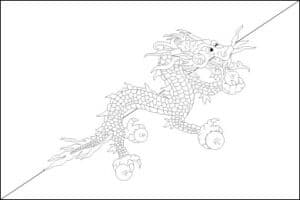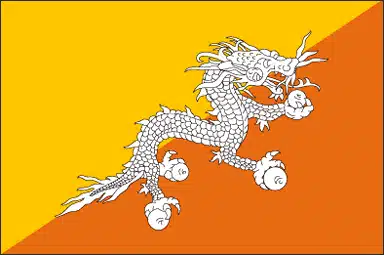
The Bhutanese national flag, which is one of the national symbols of the Kingdom of Bhutan, was officially adopted in 1969. It consists of a diagonal division into two halves: the upper left half is orange/yellow, and the lower right half is orange.
In the center of the flag, there is an emblem of a white dragon facing towards the right. This dragon holds jewels in its claws, symbolizing the wealth of the nation.
The fierce expression on the dragon’s face represents the strength of the Bhutanese people in safeguarding their country. The orange color represents the Drukpas monasteries and the Buddhist religion, while the orange/yellow color represents the secular authority of the King.
The white color signifies purity and loyalty.
Facts about Bhutan flag |
| Country | Bhutan |
|---|---|
| Designed by | Mayeum Choying Wangmo Dorji |
| Adopted | 1969 |
| Revision | 1949, 1956 |
| Design and Colors | Divided diagonally from the lower hoist-side corner; the upper triangle is yellow and the lower triangle is orange; centered along the dividing line is a large black and white dragon facing away from the hoist side |
| Size Ratio | 2:3 |
| Official Name: | The Kingdom of Bhutan |
| Proportion: | 2:3 |
| Adopted on: | 1969 |
| Location: | Eastern end of the Himalayas bordered by the Republic of India, and China |
| Capital City: | Thimpu |
| Major Cities: | Paro, Atsho Chhubar, Zhemgang |
| Area: | 14,824 square miles |
| Population: | 708,427 |
| Currency: | Ngultrum (BTN) |
| Official Language: | Dzongkha |
| National Anthem: | Druk Tsendhen |
| National symbol(s): | thunder dragon known as Druk Gyalpo |
| National colors: | orange, yellow |
Historical Background
The current design of the Bhutan flag was officially adopted in 1969. It was designed by Mayum Choying Wangmo Dorji, the sister of the third king of Bhutan, Jigme Dorji Wangchuck. The flag’s design has remained unchanged since then, symbolizing the enduring principles and traditions of Bhutan.
Design and Colors
The Bhutan flag features a diagonally divided field with the upper yellow half and the lower orange half. In the center, there is a large white dragon, known as the Druk, with its claws reaching both the upper and lower halves of the flag.
Symbolism of the Bhutan Flag
Each element of the Bhutan flag holds deep symbolism. The yellow color represents the civil tradition and secular authority of Bhutan. It symbolizes the flourishing spiritual and secular traditions of the country. The orange color represents Buddhism, the state religion of Bhutan, and the spiritual traditions of the country. The white dragon, known as the Druk, is a symbol of Bhutanese mythology and represents the name of Bhutan itself. The dragon’s reaching claws symbolize the protection of the secular and spiritual traditions of the nation.
FAQs
Q1: When was the current design of the Bhutan flag adopted?
The current design of the Bhutan flag was officially adopted in 1969.
Q2: What do the colors on the Bhutan flag represent?
The yellow color represents civil tradition and secular authority, while the orange color represents Buddhism and the spiritual traditions of Bhutan.
Q3: What does the white dragon on the Bhutan flag symbolize?
The white dragon, known as the Druk, is a symbol of Bhutanese mythology and represents the name of Bhutan itself. It symbolizes the protection of the secular and spiritual traditions of the nation.

